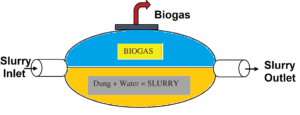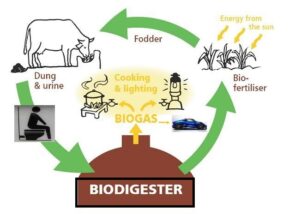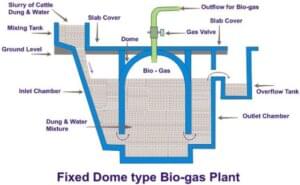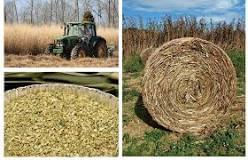Introduction to Biogas Plant
- A biogas plant is used to generate wet natural gas for domestic cooking.
- This gas is ideally generated in oxygen-free conditions due to anaerobic digestion
- This is a conversion system where you can turn waste into sustainable energy and fertilizers, with positive effects on the environment.
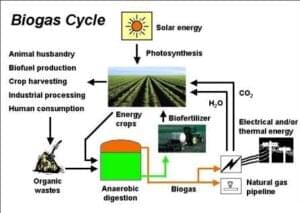
What is biogas?
- Biogas is a renewable source of energy that is produced by the breakdown of organic matter such as food waste, animal manure, and agricultural waste
- The process of producing biogas is known as anaerobic digestion, which takes place in a biogas plant
- In this process, microorganisms break down the organic matter to produce methane (CH4) and carbon dioxide (CO2)
- Preparation of slurry for Biogas
Properties of Biogas
- LPG can be replaced with biogas
- 1 L LPG = 1.05 m3 of biogas
- 1 kg LPG = 2.1 m3 of biogas
- The density of Biogas: 1.15 kg/m3
- The calorific value of 1 m3 biogas is equivalent to 0.6 – 0.8 liters of kerosene
How use the Biogas Plant at your home?
- Biogas plants provide a sustainable solution to waste management and energy generation. The organic waste that would otherwise be sent to a landfill can be used to produce biogas, reducing the amount of waste that goes to the landfill and reducing the release of methane, a potent greenhouse gas
- Moreover, the biogas produced in a biogas plant can be used as a source of energy for heating, cooking, and even electricity generation
- Biogas plants come in various sizes, ranging from small domestic systems to large commercial plants
- The size of the plant is determined by the amount of waste generated and the energy demand
- The biogas plant process starts with the collection of organic waste, which is then processed in an anaerobic digester
- The biogas produced in the digester is cleaned and processed to remove impurities such as moisture, carbon dioxide, and other gases
- The resulting biogas can then be used as fuel for heating or for electricity generation
- One of the main advantages of biogas plants is their ability to produce energy from waste that would otherwise be sent to a landfill
- This reduces the environmental impact of waste disposal and provides a sustainable solution to energy generation
- Biogas plants have low carbon emissions which makes more an environmentally friendly solution to energy generation
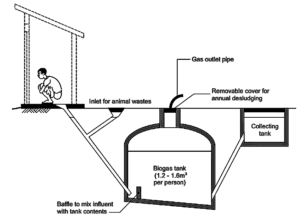
How much biogas is produced from cow dung?
- According to recent studies, one kilogram (2.2 pounds) of cow manure can produce from 15 to 30 liters of biogas per day
- Biogas yielding can be increased up to 40 liters per day.
- A cow is assumed to produce around 10 kg of dung per day
- One kilogram of cow dung produces around 0.036 cubic meters of biogas.
What are the Benefits and Costs of a Biogas Plant?
- A biogas plant supplies energy and fertilizer. It improves hygiene and protects the environment
- A biogas plant can reduce the cost of LPG and electricity consumption
housewife - It is a modern energy source
- Improves life in the country with green energy
- An abundant supply of energy
- By diverting people for cooking purposes, the cost of cooling can be brought down the cooking cost by 80%
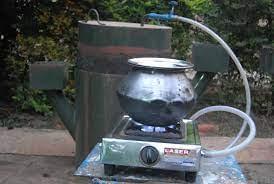
Types of Biogas Plants
- Biogas plants are classified based on types of digestor design
- There are normally three main types of simple biogas plants
- Balloon dome plants
- Fixed-dome Cement plants
- Floating-drum plants.
- A balloon biogas plant consists of a plastic or rubber digester at the top to store gas
- The following are major types of Biogas Digesters
- Balloon (flexible rubber) Plants
- Fixed Dome Biogas Plants
- Floating Drum Plants
- Low-Cost Polyethylene Tube Digester
- Horizontal Plant
- Earth-pit Plants
- Ferro-cement Plants.
Fixed Floating Biogas Plant
- A fixed-dome plant consists of a closed, dome-shaped digester with an immovable
- It is made of a top rigid gas tank and a displacement holding which is called a gas holder or compensation tank
- The biogas is stored in the top portion of the digester
- . When biogas (wet methane) gas production starts, the slurry is displaced into the side compensating tank
- The fixed dome has limited gas storage and more cost

Floating Biogas Plant
- The construction of a floating biogas plant is similar to a fixed dome. The dome is replaced with flexible polyethylene bags
- This consists of an underground digester and a moving gas holder
- The floating can be cylindrical, hemispherical, or rectangular in shape
- The top gas holder floats either directly on the fermentation slurry or in a water jacket of its own
- The biogas is collected in the gas drum, which can rise or fall as per gas pressure
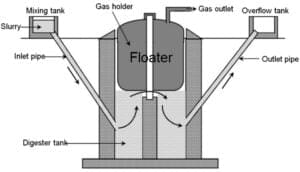
- The following figure shows the details of the floating biogas digestor
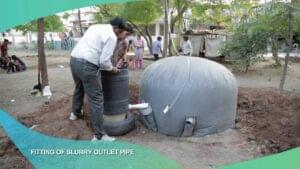
Portable Biogas Plant
- These units are designed for household and institutional purposes
- Portable biogas plants generate enough energy from the biodegradable wastes
- Benefit: hygienic environment and healthy surroundings for individual households as well as the general public.
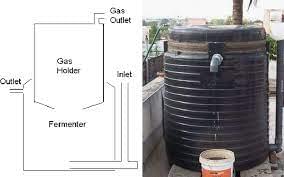
- Portable biogas plant uses plastic tanks for digestor and slurry pipes
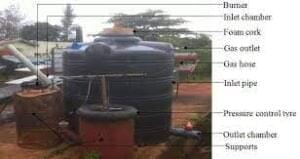
- The upper gas holder can be replaced by a plastic container
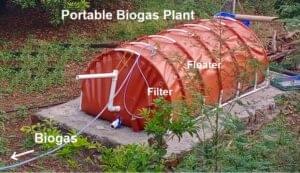
Ballon Type Biogas Plant
- This biogas plant uses a flexible rubber bag (balloon) as heat-sealed plastic which combines digester and top gas-holder
- The gas is stored in the upper part of the balloon
- The inlet and outlet are attached directly to the skin of the balloon.
- Gas pressure can be increased by placing weights on the balloon
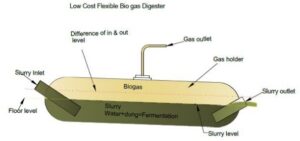
- The ballon type biogas plants can be semiautomatic

Advantages of Floating dome biogas Plants
- Floating-drum plants are easy to understand and operate
- They provide gas at constant pressure, and the stored gas volume is immediately recognizable by the position of the drum
- Gas tightness is no problem, provided the gasholder is de-rusted and painted regularly
- Depending on the capacity and materials that come with the plant, the price can vary from Rs 10,000 to Rs 25 lakh (USD 12000)
- The area of the bottom 50×50 square feet of space; and if it’s a plug-in model, then a 20-square foot area.
Comparison of Fixed and Floating Dome Biogas Plant
- The fixed dome is more popular in India due to low construction costs, the absence of moving parts, and rusting steel parts
- If it is well-constructed, fixed dome plants have a long lifespan
- The underground construction saves more space and protects the digester from temperature changes
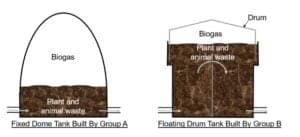
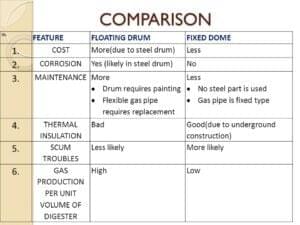
Biogas Composition
- Biogas is a wet Natural gas
- Biogas is generated biologically from renewable biomass
- To reduce pollution from fossil fuels, biogas consumption can achieve greenhouse gas (GHG) emissions reductions to help for worldwide climate change mitigation strategies
- Biogas generated is generally composed of:
- Methane – CH4 (55-65%)
- Carbon dioxide -CO2 (35-45%
- H2S (100-10000 PPM)
- Water vapor -H2S (saturated at biogas temperature)
- Ammonia NH3, (traces)
- Like biogas, natural gas is composed primarily of methane
- Biogas is a wet natural gas (WNG). Its purity is diluted due to carbon dioxide (CO2) and some corrosive gases
- Biogas generated from landfills has less Methane (CH4) in proportion. This is because of the surrounding air (Nitrogen & oxygen) gets mixed into the biogas collection top.

How much energy Production by Biogas Plant?
- Each cubic meter (m3) of biogas contains the equivalent of 6 kWh of heat energy
- The same volume of biogas converted to electrical power yields 2 kWh; the rest of the energy is dispersed as heat that can be reclaimed and applied to other uses.
- Biogas can provide energy
- for 1 m³ of masonry: 1000 kWh or 180 m³ of biogas
- for 100 kg of steel: 800 kWh or 150 m³ of biogas,
- for 1 kg of oil paint: 170 kWh or 28 m³ of biogas
- Construction and maintenance also consume energy:
– for 1 km of transport by lorry, about 1.5 kWh or 1.05 m³ of biogas
– for 1 km of transport by car, about 0.5 kWh or 0.35 m³ of biogas.
A biogas plant must operate for one or two years before the energy put into it is recovered.
How much biomass is consumed to produce biogas?
- 30 kg of organic food waste such as sugar, starch, cellulose, protein, or fat) yields 1 kg of biogas
- Normally Biogas plants transform only 10% of the mass they process into biogas
- The remaining 90% of the mass fed into the digester comes out as a fertilizer called digestate.
- It must have a long-term inexpensive outlet for this digestate otherwise the project will not succeed.
How Biogas is produced?
- Anaerobic Digestion is an important process to generate biogas which is called a Biogas Digester
- In this process, bacteria help to biodegrade organic matter like solid animal manure, bio waste, and food waste
- This process is achieved in the absence of oxygen (o2)
What is Anaerobic Digestion?
- Anaerobic digestion is a natural bacterial process by which a consortium of anaerobic bacteria biodegrading organic matter in an environment without oxygen
- These bacteria require a favorable environment to thrive
- There are several bacteria work together to convert waste material (digestible volatile solids) within the feedstock converted into biogas
- But most feedstocks are mainly composed of water which can not help with biogas generation.
- You can make biogas out of the digestible fraction of the solids within the feedstock
- Lignocellulosic-like soft material (wood, organic waste) contains solid volatile materials which are burnable) but they are not digestible in an anaerobic digester
- The process of conversion of solids into biogas makes the substrate more liquid. This is due to feeding solid materials into liquid digesters without clogging
Factors Affecting Anaerobic Digestion?
- The following are the key factors to efficient anaerobic digestion.
- Proper temperature (> 25 C)
- lack of oxygen (absence of oxygen)
- Proper feeding of waste with a constant rate
- Acidity
- Feedstock mixing
- The anaerobic digestion process takes place in equipment called anaerobic digesters or, in short, digesters
- Digesters must be fed as constantly as possible regardless of feedstock fluctuations
- Biogas is composed mainly of methane (CH4) and carbon dioxide (CO2).
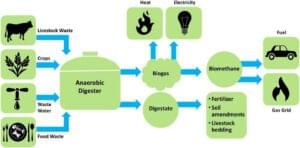
Biomethanation
- This is a process by which organic material is microbiologically converted under anaerobic conditions to biogas
- Three are the main physiological groups of microorganisms :
- Fermenting bacteria
- Organic acid-oxidizing bacteria
- Methanogenic archaea.
Role Feedstock to Enhance Biomethanisation
- The feedstock needs the biogas technology to be used, not the other way around
- For the effective design of a biogas plant, we need to fully understand its feedstock
- The composition of the feedstock must be known to find out the best suitable technologies for faster bioprocessing material
- Proper understanding of feedstock composition allows us the predictions of digestate quality which will help identify outlets for the digestate
- The following feedstock properties are checked
- pH
- Alkalinity
- Dry matter content or total solids (TS)
- Volatile solids (VS)
- Total Kedjhal Nitrogen (TKN)
- Contaminants (plastics, glass, metals, etc.)
- The following feedstocks are commonly used in anaerobic digesters
-
- Food cafeteria wastes.
- Milkhouse wash water
- Fresh produce wastes
- Industrial biowastes
- Sewage sludge
Technology Used for Biogas Processing
- Anaerobic digestion processing technologies are divided into two major families:
- Wet digestion
- Dry digestion
Wet Digestion
- The process is considered wet digestion when the content of the digester is pumpable
- That means that the material inside the digester has a consistency of approximately 10% dry matter or less (90% water)
- There exist many configurations of wet digesters:
- Complete mix or Completely stirred tank reactor (CSTR)
- Plug-flow
- Upflow Anaerobic Sludge Blanket (UASB)
- Fixed film reactor
- Floating films reactors
- Sludge bed reactors
- These configurations have been designed to optimize the process for various feedstock conditions and market applications
Dry Digestion
- The process is considered dry digestion when the content of the digester is not pumpable
- The material inside the digester has a consistency of approximately 10% dry matter or more
- There exist many configurations of dry digesters:
- Continuous vertical
- Continuous horizontal
- Batch (Garages)
- These configurations have been designed to optimize the process for various feedstock conditions and market applications
- The mass balance of a typical dry digestion process
Which Digestion is better, wet or Dry?
- As illustrated in the examples above, there is no silver bullet, and it is not true that dry digestion resolves all wastewater issues since composting plants have leachate treatment challenges of their own
- In the example above, using the wet digestion process resulted in 100 tonnes of SSO being converted into 45 tonnes of solid digestate and approximately 100 tonnes of wastewater (some recycled)
- The result of the dry digestion process is 80 tonnes of compost recycled to land and processed within a composting plant of equal size to the biogas plant
- Normally, it is possible to remove ammonia from the wastewater wet digestion is preferred, and if composting is possible dry digestion is used.
Use of Biomass for Thermal Energy
- Depending on H2S or siloxanes) biogas may be cleaned or not and fed into a boiler to make hot water or steam for industrial applications
- Boiler efficiency can be as high as 95%, so almost all the biogas energy gets converted into useful energy (hot water, steam, or hot air)
- However, natural gas equipment must be converted in order to burn biogas efficiently since biogas has less energy because it contains 40% CO2, which is not a fuel
Can we use Biomass as Natural Gas?
- Biogas can not be compressed directly like CNG and used for vehicles. This is because of its corrosive gases. Biogas needs to compromise the safety of the high-pressure cylinders
- Biogas will be used as LPG gas after removing its H2S, CO2, and H2O
- Biogas is converted to renewable natural gas (RNG) or biomethane which can fill up like CNG for gas vehicles
Biomass Storage
- Biogas is typically stored at near atmospheric pressure
- Since biogas in its raw form is wet and corrosive, it cannot be stored in pressure vessels because it will cause corrosion leading to safety issues
- Pressure storage is possible only if the biogas has been upgraded to renewable natural gas pipeline specifications
- Storage at atmospheric pressure takes up a significant volume.
Conclusion
- Biogas plants provide a sustainable solution to waste management and energy generation
- By using organic waste to produce biogas, biogas plants reduce the environmental impact of waste disposal
- It provides a source of clean energy, and promote sustainable development
- Investing in a biogas plant is an investment in a cleaner, greener future.

